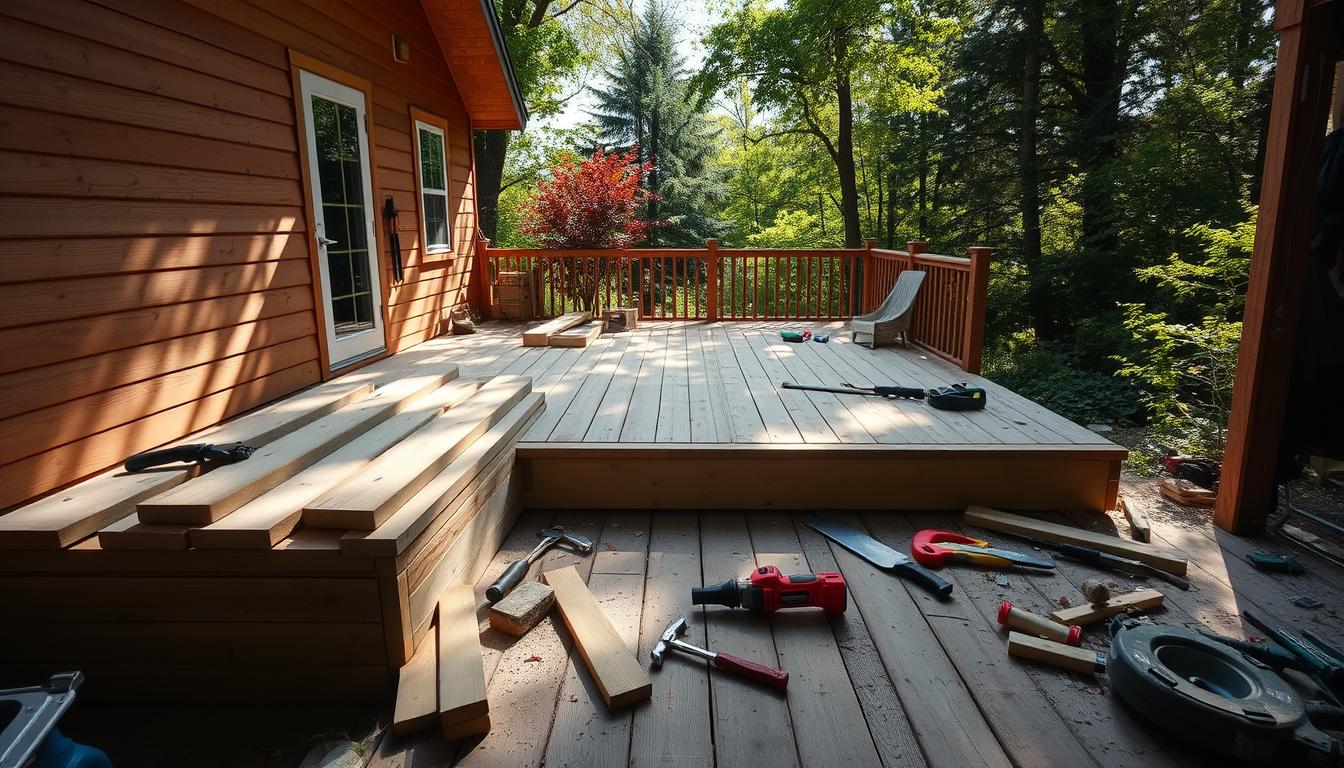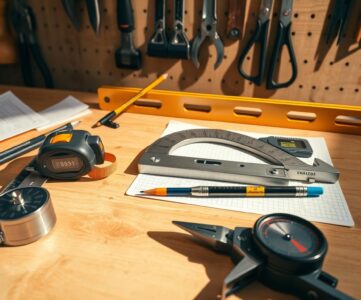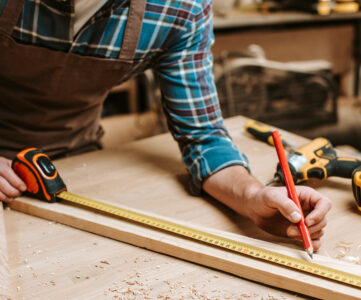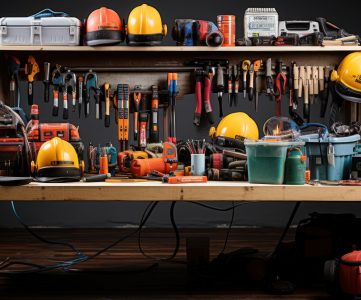Welcome to our comprehensive guide on deck construction and planning. We’ll take you through the entire process of creating your dream outdoor living space. Whether you’re a seasoned DIY enthusiast or a beginner, this guide will equip you with the knowledge and skills to build a beautiful and functional deck.
Deck construction and planning are key steps in creating a stunning outdoor space. Our guide will cover everything from planning and designing your deck to choosing the right materials and building it. We aim to help you create a space that meets your needs and complements your home’s architecture.
In this guide, we’ll walk you through the entire process, offering expert tips and advice on deck construction and planning. By the end of this guide, you’ll have the confidence and knowledge to create a deck that you’ll enjoy for years to come.
Introduction to Deck Building
Our goal is to provide a comprehensive guide that covers all aspects of deck construction and planning. We aim to help you create a beautiful and functional outdoor living space that meets your needs and complements your home’s architecture.
Key Takeaways
- Deck construction and planning are crucial steps in creating a stunning outdoor space
- Choosing the right materials is essential for a durable and long-lasting deck
- A well-planned deck can increase your home’s value and enhance your outdoor living experience
- Deck construction requires careful planning and attention to detail
- Our guide will provide you with expert tips and advice on deck construction and planning
Planning Your Perfect Deck Design
Creating your ideal outdoor living space begins with a well-planned deck design. It’s where you can relax, entertain, and spend quality time with loved ones. To start, assess your available space, determine the deck’s purpose, and set a budget.
Deck design must consider traffic flow and planned activities. For dinner parties, ensure there’s space for a dining table and chairs. Outdoor living aims to blend indoor and outdoor spaces smoothly. Think about how your deck will connect to your home and yard.
- Assessing your yard’s slope and terrain to determine the best location for your deck
- Considering the style and architecture of your home to ensure your deck complements it
- Thinking about the types of activities you’ll be using your deck for, such as dining, lounging, or entertaining
By carefully planning your deck design, you’ll create a beautiful, functional outdoor space. It will meet your needs and improve your outdoor living experience.
Essential Deck Building Permits and Regulations
Before embarking on your deck project, securing the required building permits and adhering to local laws is paramount. This often-overlooked step is critical for ensuring your deck’s safety and legal compliance. Neglecting to obtain necessary permits can lead to hefty fines, penalties, and even the removal of your deck.
To successfully navigate the permitting process, you must submit your deck’s plans and specifications to your local building department. They will scrutinize your plans to verify they adhere to local building codes and regulations. This may involve obtaining building permits, zoning approvals, and environmental permits.
- Ensure your deck plans are detailed and accurate
- Submit all required documentation, including plans, specifications, and permits
- Pay the required fees for the permits and inspections
- Schedule inspections with the building department to ensure compliance
By adhering to these guidelines and obtaining the necessary building permits, you can guarantee your deck’s construction meets safety standards. Remember, the cost of obtaining permits is a small investment for the assurance that your deck is built to code and safe for use.
Choosing the Right Deck Materials
When building a deck, picking the right materials is key for both durability and looks. You have many options, each with its own cost, upkeep, and style. Wood decking and composite decking are two top picks, each with its own set of benefits.
Wood decking, like cedar or pressure-treated lumber, brings a natural charm. It’s also cheaper than composite materials. Yet, it needs regular care to avoid rot and bug damage. Composite decking, made from plastic and wood fibers, is low maintenance and resists rot and bugs.
Wood vs Composite Decking
Here’s a quick comparison of wood and composite decking:
- Cost: Wood decking is less expensive than composite decking
- Maintenance: Composite decking needs less upkeep than wood decking
- Durability: Composite decking is more resistant to rot and insects than wood decking
Hardware and Fasteners Guide
Choosing the right hardware and fasteners is crucial for a deck’s stability. Look for screws, nails, and bolts that resist corrosion and can handle the weather. Brands like Trex and Deckorators are popular for these needs.
Foundation Material Options
A strong foundation is vital for a deck’s safety and stability. You can use concrete footings, piers, or helical piers. The right choice depends on the deck’s size, design, and local building rules.
| Foundation Material | Description |
|---|---|
| Concrete Footings | A traditional foundation material that provides a solid base for the deck |
| Concrete Piers | A pre-cast concrete pier that is quick and easy to install |
| Helical Piers | A deep foundation system that is ideal for decks built on unstable soil |
Required Tools and Equipment Checklist
Before embarking on your deck construction project, it’s vital to gather the necessary tools and equipment. This step ensures a seamless and efficient process, leading to a durable deck that will stand the test of time. You’ll need a variety of power tools, such as circular saws, drill presses, and impact drivers, for deck construction.
Hand tools are equally important, including hammers, tape measures, and levels. These tools are essential for tasks like measuring, cutting, and assembling the deck’s components. A detailed checklist should include:
- Power tools: circular saws, drill presses, impact drivers
- Hand tools: hammers, tape measures, levels
- Fasteners: nails, screws, bolts
- Safety equipment: hard hats, safety glasses, gloves
Having the correct tools and equipment will significantly ease and enhance the safety of your deck construction project. Always adhere to safety guidelines and follow the manufacturer’s instructions when operating power tools and equipment.
Professional Deck Building Techniques
Deck construction starts with a solid foundation for durability and longevity. A professional deck builder will meticulously plan your deck’s size, shape, and location. They consider sunlight, wind, and drainage to find the perfect spot in your yard.
The foundation layout is the initial step in deck construction. It involves marking the deck area and laying out footings and piers. A skilled deck builder uses specialized tools to ensure the foundation is level and secure.
Foundation Layout Methods
Deck construction employs various foundation layout methods. String lines and batter boards are used to guarantee a square and level foundation. These techniques ensure your deck meets building codes, creating a lasting foundation.
Post Installation Tips
After laying the foundation, installing posts is the next step. This requires digging holes and setting posts in place with concrete. A professional deck builder ensures posts are level and secure, preparing your deck for heavy loads and harsh weather.
Proper Beam Construction
Proper beam construction is essential for a sturdy and safe deck. The right lumber and adherence to building codes are crucial. A professional deck builder focuses on constructing beams correctly and securing them to posts, creating a solid deck framework.
Mastering Deck Framing Basics
Deck framing is a critical part of deck construction. It forms the base of the entire structure. A solid frame ensures the deck’s stability and safety. On the other hand, a weak frame can pose safety risks and require expensive fixes.
To excel in deck framing, understanding the various frame types is key. These include platform, cantilever, and hillside frames. Each has its own features and needs. The choice depends on the deck’s design and location.
Important factors in deck framing include:
- Joist spacing: The distance between joists impacts the deck’s stability and weight it can hold.
- Beam placement: Beams add support and help spread the weight evenly.
- Material selection: The frame’s material, like wood or composite, affects durability and upkeep.
By grasping these elements and adhering to deck construction best practices, homeowners can build a safe and inviting outdoor area. This space will serve as a lasting extension of their home.
A well-built deck frame is the foundation of a safe and enjoyable outdoor living space. With proper planning and execution, homeowners can create a deck that meets their needs and enhances their home’s value.
Installing Your Deck Boards
Choosing the right deck materials is key when installing deck boards. Wood decking stands out for its natural beauty and durability. To achieve success, it’s vital to follow some essential tips and techniques.
First, consider the spacing and alignment of your deck boards. Proper spacing accommodates wood expansion and contraction. Alignment ensures a smooth, even surface. It’s also important to check the deck materials for any defects or warping before installation.
Spacing and Alignment Tips
- Leave a 1/4 inch gap between each deck board
- Use a spacer or a nail to maintain even spacing
- Check the alignment of the deck boards regularly during installation
Cutting and fitting techniques are also critical when working with wood decking. The right tools and techniques significantly impact the final result.
Cutting and Fitting Techniques
For cutting deck boards, a miter saw or circular saw is best for clean, precise cuts. When fitting boards together, use a rubber mallet to tap them into place. Avoid nails or screws that can split the wood.
By adhering to these tips and techniques, you can create a professional-looking deck with wood decking that will endure for years. Always opt for high-quality deck materials and follow proper installation procedures. This ensures a safe, enjoyable outdoor living space.
Building Safe and Sturdy Railings
In deck construction, safety is paramount. Railings are key to preventing accidents and ensuring a secure outdoor space. A well-constructed railing enhances your deck experience.
Choosing the right material for your railings is crucial. Wood and metal are common choices, each with its own benefits and drawbacks. Wood adds warmth, while metal offers a modern look.
Key considerations for safe railings include:
- Post installation: Posts must be firmly anchored to the deck floor.
- Baluster spacing: Balusters should be spaced to prevent accidents.
- Height and width: Railings must meet height and width standards.
By adhering to these guidelines and considering your deck construction and outdoor living needs, you can create durable and safe railings. These will provide years of enjoyment and peace of mind.
Adding Custom Features and Details
Creating a unique and functional outdoor living space requires custom features and details. A well-designed deck can be enhanced with built-in seating, lighting, and storage. These elements not only boost the deck’s aesthetic but also make it more comfortable and practical for outdoor use.
Consider adding built-in planters, outdoor kitchens, and fire pits to your deck design. These features can turn your deck into a welcoming and cohesive space. For instance, built-in planters can introduce greenery, while an outdoor kitchen offers a space for entertaining.
To craft a distinctive outdoor living area, think about these features:
- Built-in seating options, such as benches or sofas
- Lighting installation, including string lights or lanterns
- Storage solutions, such as cabinets or shelves
These elements can be customized to suit your needs and enhance your deck’s design. This way, you’ll have a space that’s both functional and visually appealing for outdoor living.
| Feature | Description |
|---|---|
| Built-in Seating | Provides a comfortable and functional space for relaxation |
| Lighting Installation | Enhances the ambiance and safety of your outdoor living space |
| Storage Solutions | Keeps your outdoor living space organized and clutter-free |
By integrating these custom features into your deck design, you can create a unique and functional outdoor space. Whether for entertaining, relaxation, or simply enjoying the outdoors, a well-designed deck with custom elements is ideal. It offers the perfect setting for your outdoor living needs.
Weather Protection and Sealing
Choosing the right sealant is key to protecting your deck from the elements. With various deck materials, like wood decking, finding a sealant that matches your deck’s characteristics is crucial. A good sealant shields your deck from water damage, preventing warping and cracking.
Sealants come in two main types: water-based and oil-based. Water-based sealants are simpler to apply and clean up. On the other hand, oil-based sealants offer a more lasting finish. The type of deck materials, such as wood decking, will help you choose the best sealant.
Choosing the Right Sealants
Some popular sealant options include:
- Acrylic-based sealants, suitable for most deck materials
- Polyurethane-based sealants, ideal for wood decking
- Silicone-based sealants, providing excellent water resistance
Application Techniques
To ensure a successful application, follow these steps:
- Clean your deck thoroughly to remove dirt and debris
- Apply the sealant according to the manufacturer’s instructions
- Use a high-quality brush or roller to achieve a smooth finish
By selecting the right sealant and applying it correctly, you can safeguard your deck against the elements. This way, you can enjoy your outdoor space for many years.
| Sealant Type | Deck Material | Application Method |
|---|---|---|
| Acrylic-based | Most deck materials | Brush or roller |
| Polyurethane-based | Wood decking | Brush or spray |
| Silicone-based | Water-resistant decks | Brush or caulk gun |
Deck Maintenance Best Practices
Regular maintenance is key to extending your deck’s life and ensuring it remains safe and enjoyable. A well-maintained deck boosts your home’s curb appeal and offers a comfortable spot for relaxation and entertainment.
Some essential deck maintenance tasks include:
- Regular cleaning to remove dirt and debris
- Inspection for damaged or rotten boards
- Repair or replacement of damaged components
- Application of sealants or stains to protect the wood
By adhering to these maintenance best practices, you can enjoy your outdoor space for years. Always follow safety guidelines when maintaining your deck. If unsure, consider professional help. Proper maintenance is crucial for a long-lasting, functional deck, essential in any successful deck construction project.
With consistent maintenance, your deck will stay beautiful and functional, perfect for relaxation, entertainment, and creating memories with loved ones.
Conclusion: Enjoying Your New Outdoor Living Space
Congratulations on finishing your deck building project! Your new outdoor space opens up a world of possibilities. Begin by adding comfortable seating, a cozy fire pit, and lush plants. This will create a welcoming atmosphere. Make sure your deck design reflects your style and complements your home.
Use your outdoor area for unforgettable gatherings and events. Whether it’s a dinner party, BBQ, or game night, your deck is perfect for creating memories. Don’t forget to keep your deck in top shape. Regularly apply sealants and clean the surface to preserve its beauty and functionality for years.






